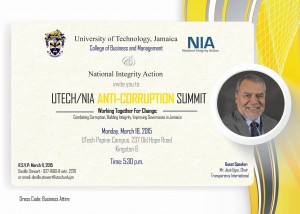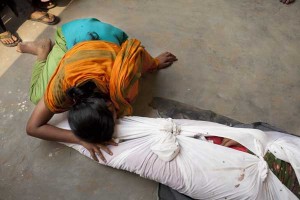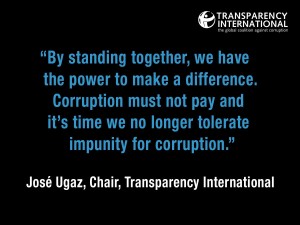
Corruption Kills
March 17th, 2015
Just as the sun set over the UTech campus this evening, the Chair of Transparency International (TI) José Carlos Ugaz made this dramatic assertion. The steadily growing audience (and it was a very decent-sized crowd, including many young people) sat up and took notice. The occasion was the University of Technology (UTech)/National Integrity Action (NIA) Anti-Corruption Summit on the front lawns of the UTech campus in Kingston.

The Anti-Corruption Summit was a collaboration of UTech and NIA (which is now an official chapter of Transparency International).
What did Mr. Ugaz mean? Does corruption really kill? How does that work? The TI Chairman (whose amiable air contrasted strangely with the disturbing information he provided) talked to us about what he called Grand Corruption. Compared to twenty years or so ago, he observed, the nature of what we all saw as corruption has changed. Then, TI roughly defined the word as “abuse of power for personal gain,” referring primarily to public sector officials and especially in developing countries. It was someone getting caught with their hand in the till (or the cookie jar). It was administrative theft. Plus, of course, there was the mafia, which had its own limited geographical space, a strict organization with its own rules, a hierarchical structure.
Occasionally, a head of state was found to be corrupt on a quite spectacular scale. Sani Abacha of Nigeria, for example, whose administration was riddled with the misappropriation of public funds. After his death in 1998 (he was in power for less than five years) over US$1 billion was recovered and many more hundreds of millions were later found. Then there was Ferdinand Marcos of the Philippines – whose wife was overly fond of footwear, if you recall. He allegedly embezzled an estimated US$10 billion from his country, which suffers from crippling poverty to this day. And then there was President Mohammed Suharto of Indonesia; and President Mobutu Sese Seko of Zaire (now Democratic Republic of Congo), who stole half the considerable sums of aid money his country received back in the 90s.
But those were the good old days of corruption – relatively speaking. Now, Mr. Ugaz tells us, the paradigm has shifted and “the boundaries are diluted.” Corruption has gone global, and in a big way.It has changed gears. The corrupt ones use very sophisticated financial tools. They are powerful actors, shifting “huge amounts of money” around. They are infinitely scarier than those greedy public officials. They are powerful, with weapons and even private armies. It’s high-tech international organized crime, with the benefit of highly flexible networks. We don’t have to look far from our shores to find it flourishing in countries like Mexico and Honduras – poor countries with high levels of corruption and crime. Now, these new corrupt networks can “capture a state,” Mr. Ugaz informs us.
And of course, financing terrorism is not against their rules. In fact, nothing is really against the rules in this brave new corrupt world. This is grand corruption, involving everyone from lawyers to shopkeepers, from drivers to IT experts, from bankers to police officers. It’s all hands on deck.
José Ugaz presented some unnerving statistics. Just to give us an idea of the scale, he discussed global tax evasion (using illegal means to avoid paying taxes), estimated at roughly US$3 trillion. Tax evasion impoverishes millions, depriving people of government services, employment opportunities and a higher standard of living. Those who are cheating on their taxes often whisk their funds away overseas; the total amount of money leaving poor countries is roughly US$6 trillion. Money in tax havens (and there is one very close to Jamaica) is estimated at US$32 trillion. Can you imagine how these trillions would help lift up communities, cities, whole nations? This issue hit especially close to home as we sat under the stars in Kingston.
So, here’s another question: Which comes first, poverty or corruption? What is the relationship between the two? Mr. Ugaz seemed to anticipate this question coming up from the audience – and answered it himself. Poverty is a major consequence of corruption, according to recent findings. People are poor because of corruption, and not vice versa.

Victim of corruption: A woman grieves over the body of a factory worker killed in the building collapse at Rana Plaza, Bangladesh. (Photo: K M Asad).
Let’s go back to the victims of corruption: Those who are killed, made sick and injured as a direct result of it. These are not only the victims of organized crime or terrorism – and there are many, many thousands of those. Mr. Ugaz gave us several examples; here is one. Over 1,000 people died and 2,500 were injured when a commercial building collapsed in Savar, Bangladesh just two years ago. The building was built without proper permits and with substandard materials. The rules were bent. The workers received extremely low wages to work in a building with huge cracks appearing in the walls. As the TI Chair noted, human rights is now a major feature in the landscape of corruption – in a thousand different ways. Labor rights, environmental rights, sexual and reproductive rights…and the right to life.

The raging fire at Riverton City last week. This aerial view was posted on Twitter by William Mahfood on March 12.
Right now in Jamaica, in the wake of the terrible fires that poured “smog” (smoke laden with as yet unknown toxic substances) over our capital city from the garbage dump at Riverton, people are asking questions. Did someone benefit from the fires? If so, who, and how? The fire affected hundreds of Jamaicans, including schoolchildren, the elderly and asthma sufferers. The long term impact is not yet known; have we all been inhaling carcinogens that will cause a wave of cancers in the future? And the jury is out on how the conflagration started.
Corruption is not just about morality, Mr. Ugaz concluded. It is not even just economics – bribes, payola and so on. As Governor General Sir Patrick Allen said in a heartfelt speech at an anti-corruption conference last week, we need people “who are prepared to be bloody and wounded in that fight [against corruption].” Literally, perhaps.
It is dangerous. It kills people. Have we thought about corruption this way before?
Tags: Bangladesh, corruption, Ferdinand Marcos, Honduras, Jamaica, Jose Ugaz, Kingston, Mexico, National Integrity Action, Nigeria, organized crime, Philippines, pollution, poverty, Riverton City, Sani Abacha, tax evasion, tax haven, terrorism financing, Transparency International, University of Technology
The Gleaner reserves the right not to publish comments that may be deemed libelous, derogatory or indecent.
To respond to The Gleaner please use the feedback form.
4 Responses to “Corruption Kills”
- We Are the Zoomers
- Living Online with Humans and Birds: NAOC 2020
- Human Trafficking and the Problem of Public Education
- Down Memory Lane
- Are We Ready to Recover from COVID-19?
- Road Safety Matters: Is Your Vehicle Safe?
- Sexual Harassment, Me Too, and the Minister’s Disturbing Giggle
- The Vulnerable Senior Citizens, Private Care Homes and COVID-19
- A Muddle Over Masks
- Here is Something Life-Saving You Can Do: Give Blood!





Excellent blog post. This is part of the very important discussion we in Jamaica must continue to have about corruption and its impact on our society. We must take actions taken to ensure that those who participate in corruption are held accountable.
Thank you very much! Yes, we have to continue the discussion and find solutions so that we can begin to take action. Professor Munroe describes National Integrity Action as a “social movement” and I think this is required at this time, since our political leaders have been dragging their feet…
Very good post.I will add Corruption is fostered in an environment when there is lack of accountability. We also need to ensure basic things like a level of transparency in our public sector system as well.For example why cant we see a profile of every person who sits on each public sector board.Are these board members subjected to fit and proper checks? Next thing we need to demand that appropriate and sufficient resources be made available to the guardians of corruption like the OCG , the AG and the corruption prevention commission.
Thank you. Yes, transparency and accountability go hand in hand. You have made some very good points here. Thanks so much for sharing!